Photos and Writing by Joseph Sapia
The gardening and yard references are to my house in the section of Monroe between Helmetta and Jamesburg in South Middlesex County. My yard is in a Pine Barrens outlier on the Inner Coastal Plain, the soil is loamy, on the boundary of Gardening Zones 6b and 7a.
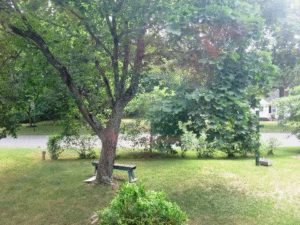
Front yard
EARLY MORNING HOURS IN THE GARDEN: On Wednesday, I got up around 5:20 a.m. for an early day at work and had the garden half-watered by 6 a.m. I watched the sky change color, listened to a crow, and watched a great blue heron fly by. Peace!
HARVESTING LETTUCE: I dug out 2 heads of lettuce and brought them to work for distribution. Worried the lettuce would start bolting in the heat wave, I was looking to use it up. It turns out there was no need to worry. The lettuce is still producing well, despite the heat.
LAST YEAR’S SUNFLOWERS: I had forgot I have last year’s sunflower crop hanging from the ceiling and drying in the garage. Well, I remembered and began spreading the seeds for the birds, squirrels, and any other wildlife that eats them.
BEARS ON THE MOVE: Various roaming black bear reports have come in over the last week or so: in South Brunswick and Milltown, for example. Stay clear and all should be OK.
FLOWERS IN THE VEGETABLE GARDEN: Cantaloupes, peas, and cucumbers are flowering, the sweet corn is in tassel, and a white flower is blooming. As for white flower, I am unsure if it is growing on its own, part of the pollinator seeds I threw down, or something else.
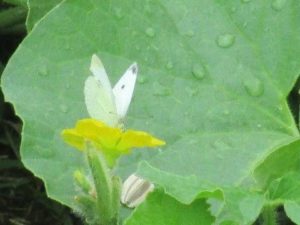
Cabbage White on Cantaloupe
“KNOCK OUT” ROSES: The “Knock Outs” seem to be doing something different this year — peaking, but retaining blooms, rather than losing all blooms until the next peak.
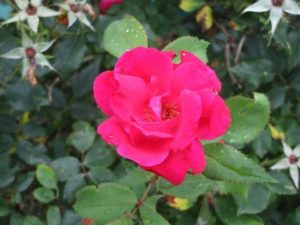
Knock Out Rose
AROUND THE YARD: Stinkhorn mushrooms are popping up.
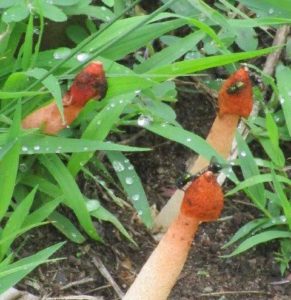
Flies on Stinkhorn Mushrooms
YARDWORK: Saturday’s thunderstorm forecast kept me from my planned trimming of the shrubs and hoeing the vegetable garden. The shrubs can wait, but I really need to attack the garden weeds on Sunday.
QUOTE OF THE WEEK: Friend Jimmy Krygier, a 3rd generation nurseryman of the 100-year Krygier’s Nursery on Cranbury Road just outside Helmetta, noted the perkiness of the vegetation as we were driving a backroad after the recent rains and he said something to the effect of, “The vegetation is smiling because of the rain. Even the weeds.”
DOWN THE SHORE: The clinging jellyfish, “Gonionemus vertens,” an invasive species indigenous to the Asian Pacific Ocean, has been found in the Shrewsbury River and Manasquan River recently. Their stings are very hurtful and could require hospitalization. They are not expected in Raritan Bay or in the Atlantic Ocean.
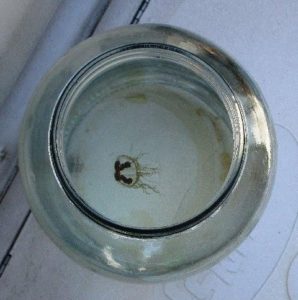
Clinging jellyfish from the Shrewsbury River at Monmouth Beach
SOMETHING TO WATCH FOR: In the local Pine Barrens, watch for the beginning of the “fall” foliage colors from around July 15 to July 30.
Joe Sapia, 59, has lived his whole life in Monroe. He is, among other things, a Pine Barrens naturalist and a vegetable gardener. He gardens the same backyard plot as did his Italian-American father, Joe Sr., and his Polish maternal grandmother, Annie Poznanski Onda. Both are inspirations for his vegetable gardening. And he draws inspiration on the local Pine Barrens from his mother, Sophie Onda Sapia, who lived her whole life in the local Pines, and his grandmother.
Photos and Writing by Joseph Sapia
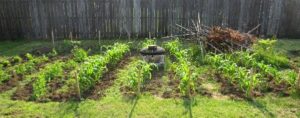
GARDEN AND AFIELD
2016, June 19, Sunday, to 2016, June 25, Saturday
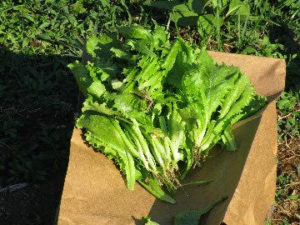
Lettuce
HARVESTING FROM THE GARDEN: I began picking lettuce, harvesting it leaf by leaf, rather than by the head, so the plant keeps producing. (In my haste, I pulled out too much leaf. So, next time, will clip them, saving the plant.) Then, I either munch on the leaf right there in the garden or take it inside for a sandwich.
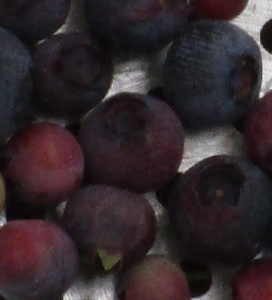
Wild blueberries
HARVESTING FROM THE LOCAL PINE BARRENS: Blueberries are ripening. I picked some the other day and mixed them into a cup of yogurt.
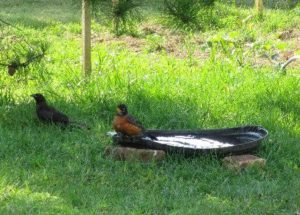
Bird bath
BIRD BATH: I keep a bird bath filled with water at ground level. Birds not only “bathe” in it, but birds and other animals drink from it.
WILDLIFE IN THE YARD: The raccoons are still taking advantage of the sunflower kernels in the bird-feeder. And, one evening, I saw a huge skunk passing by.
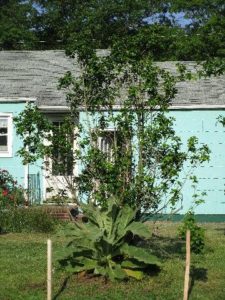
Mullein in front of the American holly
WEEDS IN MY YARD: As I have mentioned, I leave many weeds growing to see what they develop into. Well, I have a huge mullein taking over my American holly in my backyard. In the front yard, I have pokeweed growing.
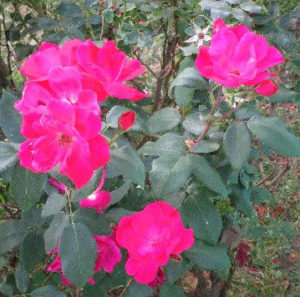
“Knock Out” roses
“KNOCK OUT” ROSES: Surprisingly, the first bloom of “Knock Out” roses continues.
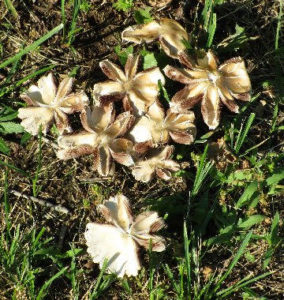
Fungi in the backyard
FUNGUS, IN YARD AND WOODS: Fungi growing in my backyard and some in the local Pine Barrens.
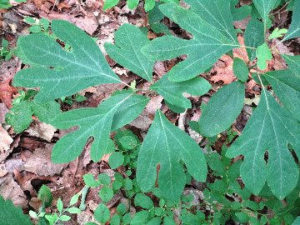
Sassafras with its three styles of leaves
SASSAFRAS IN THE LOCAL PINE BARRENS: Sassafras trees can have three leaf patterns on the same tree: a two-prong mitt, three-prong, and oval. I found an aberration this week, one with five prongs.
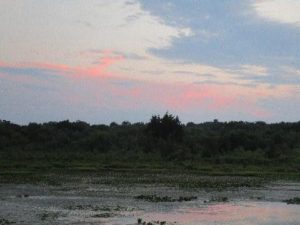
Helmetta Pond at sunset
Joe Sapia has been a professional journalist since the 1970s. He also is a writing teacher, folk artist, vegetable gardener, Pine Barrens woodsman, Helmetta area historian, and Jeep driver, along with being Marquette University Jesuit-educated..
Born in 1956, Joe is a lifelong resident of Central Jersey, where his family — through his maternal side, the old Polish and Slovak workers of the George W. Helme Snuff Mill in Helmetta — has lived since about 1900. He is a voice of the land and Old Jersey ways.
Photos and article by Joseph Sapia
Afield observations made in the Pine Barrens around Helmetta in South Middlesex County. Garden observations made in my yard, just outside of Helmetta.
THE GARDEN. Planted vegetables, cantaloupe, and flowers, all from seed, May 21. Sweet corn, cucumbers, and sunflowers are sprouting well. The tomatoes are just peeking through the soil.

GARDENING CHORES. Planted black-eyed Susan seeds, finished lawn-mowing, weeded the garden, been watering the garden.
WATERING THE GARDEN. I use no fertilizer and no chemicals — to me, things ruining the local Pine Barrens ecosystem and time bombs in the soil and groundwater. But I water, a soaking preferably before 10 a.m., so less loss of water to evaporation in the sun’s heat and allowing the vegetation to dry so as not to pick up fungal growth. If I miss the pre-10 a.m. watering, I will try to water with a sprinkling can, low to the ground, underneath the vegetation.
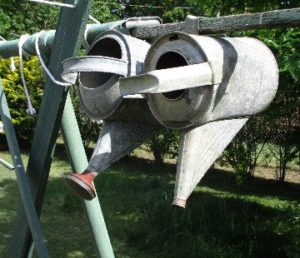
WATER CONSERVATION. Since taking over the family house in 2002, I have cut my water consumption in half for the most part. Some can be attributed to a needed bathroom remodeling (and a water-efficient toilet), but a lot is from simple conservation — do not run as much water, along with re-using gray water and rain water for watering plants. This week, for example, I watered the garden with a combination of house water and gray water, hoping to switch entirely to rain water and gray water.
MORE WATER CONSERVATION. Water from the cellar de-humidifier goes to the bird bath/watering trough. The trough, too, is recycled — a garbage can lid place on the ground, easy for birds to use, as well as squirrels and so on.
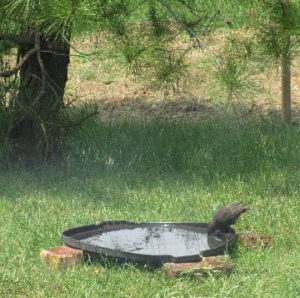
RACCOON AT THE BIRD-FEEDER. My friend continues to visit the bird-feeder, helping itself to the sunflower kernels. I let it do it for a good part of the night, then I put the feeder in the garage for the overnight.
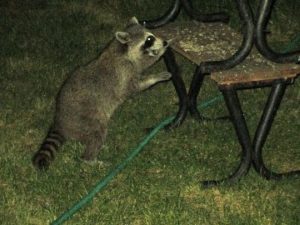
WILDLIFE AND ME. Un-rhythmic chirping crickets in my cellar in the middle of the night bring out the serial killer in me — wait till later this summer when that starts up!. But, generally, wildlife is very welcome in my yard (if not my house). This week, though, a raccoon, which I normally get within 7 or so feet of as I let it raid my bird-feeder, would not leave my garage after I startled it and it hid behind tools and so on. I poked around with a stick and finally gave up, left the doors open, and curled up on the love seat in the house until I heard rattling, meaning the raccoon was in the garbage can holding the bird seed. So, I got up, and shooed it away. Earlier, while weeding, I saw a rabbit — whose kind let me get within 5 feet or so — eating my sunflower sprouts. The hand-weeder in my hand flew across the garden. Get it? The rabbit surely understood.
WILD ON MY SIDE. Neat on the street side and neighbor side. I let my hedges and shrubs have a wild or English garden look facing inward. But I try to keep it neat on the public and neighbors’s sides. And I keep a number of wild patches in my side and back yards, making the best out of unproductive lawn ecosystems (photo 9) (I am puzzled by parents that worry about school bus stops, un-shoveled snowy sidewalks, and overcrowded classrooms, but do not worry about the chemicals on their lawns. Time bombs, I say, time bombs!)
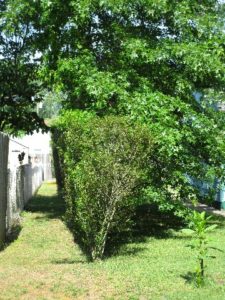
AROUND THE YARD. The season’s first bloom of Knock Out roses is wilting. Fungi (photos 11 and 12), mullein, and pokeweed sprout freely. I let this stuff grow, interested in how it looks.
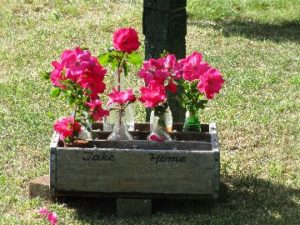
— WHAT IS GOING ON? In recent weeks, I have seen a brown thrasher (first I have seen in around 15 years), then I heard a whip-poor-will calling at my house (the first in an estimated 6 years), and, this year, the northern gray treefrogs have been hollering. Is nature coming back to the local Pine Barrens? Is the natural world becoming so condensed that nature is retreating internally? Does it mean anything?
— AND MOUNTAIN LAUREL IS BLOOMING Meaning turtles are out laying eggs, so be careful while driving. (And be careful: Do not pick them up by their tails and WATCH OUT FOR THE SNAP OF A SNAPPING TURTLE.) For the more fainthearted naturalists, the mountain laurel blooming is sort of an alarm clock that the woods will heat up, get muggy, and pine flies will be swarming.
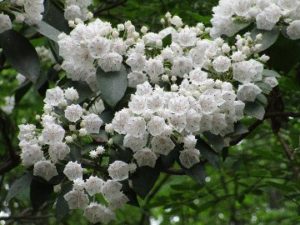
— MY INSIDE GARDEN. The view from my desk.
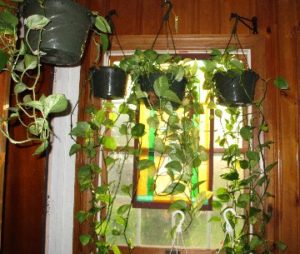
Copyright 2016 by Joseph Sapia
Joe is kicking off a new Facebook.com group, “The Jersey Midlands,” where this report is first published. To access The Jersey Midlands, go to the group and request access.
Joe Sapia, 59, is a vegetable gardener, who gardens the same backyard plot as did his Italian-American father, Joe Sr., and his Polish grandmother, Annie Poznanski Onda. Both are inspirations for his vegetable gardening. And he draws inspiration on the local Pine Barrens from his mother, Sophie Onda Sapia, who lived her whole life in the local Pines, and his grandmother.
Photos and text by Joseph Sapia
Garden and Afield in Helmetta-Monroe-Jamesburg, 2016, May 22, Sunday, to May 28, Saturday
From my yard in the Helmetta Road area of Monroe and the surrounding Pine Barrens
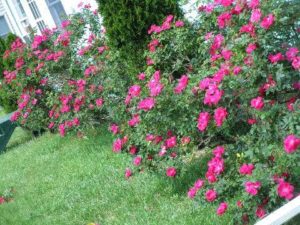
Knock-out roses
— “KNOCK OUT’ ROSES: The “Knock Out” roses are putting on a spectacular display, the best I recall since planting them in my yard in 2008.
— RACCOON/S AT THE BIRD-FEEDER: The battle continues between me and the raccoons at the bird-feeder. I have been putting the feeder in the garage at night, but the raccoon/s sometime beat me to the feeder.
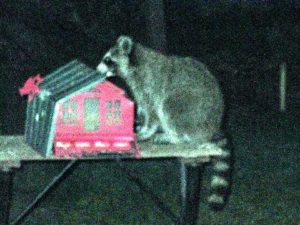
Raccoon at my backyard birdfeeder
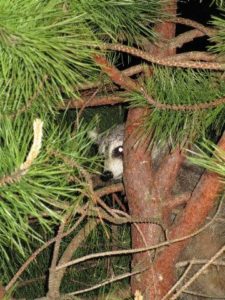
— CANADA GEESE GOSLINGS: Adult Canada geese are out and about with their goslings. The adults are amazing parents — and humans can learn from them, (Photo 6, at Helmetta Pond.)
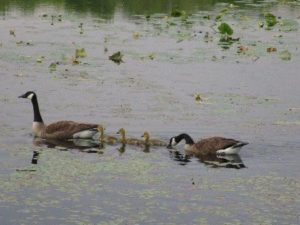
Canada Geese at Helmetta Pond
— NEW JERSEY STATE BIRD AT THE FEEDER: An Eastern goldfinch at one of my bird-feeders. Easily identified as a male because of the bright colors.
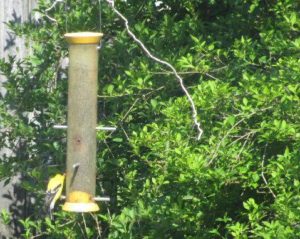
Eastern Goldfinch, the New Jersey state bird
— NORTHERN GRAY TREEFROGS: These called strongly during the week. See http://www.state.nj.us/dep/fgw/ensp/audio/no_gray_frog.wav.
— GARDEN: I planted May 21 and a week later plants were sprouting, most noticeable the Mammoth Gray-Stripe sunflower. Although I do not use fertilizer or pesticides, I water regularly. Once the plants get going, I water before 10 a.m. so as not to lose water to evaporation as the day warms.
— BLACK BEAR MOVEMENT: Reports continue about black bear sightings in Central Jersey and across the Delaware River in Pennsylvania. I am surprised there have not been more reports closer to home. If a bear is sighted, it is likely a 1-1/2-year-old male, perhaps 80 to 100 pounds, looking for its own turf. (What to do when encountering a bear, http://www.state.nj.us/dep/fgw/pdf/bear/bearfacts_know.pdf.)
— YARDWORK: I trimmed the shrubs, then started cutting the grass. I have to finish the lawncutting today. I still have to plant black-eyed Susans.
— BLAST FROM THE PAST, CIRCA LATE 1960S: Paul Migut with an 8-horsepower roto-tiller at his Uncle Stanley “Pon” Ceslowski’s garden on Old Road at Helmetta Road, Monroe. Over the years, Pon, Paul and Jim Becker worked that huge garden.
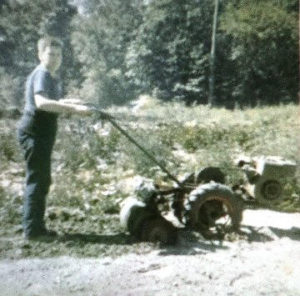
Paul Migut, circa late 1960s, at Pon’s garden
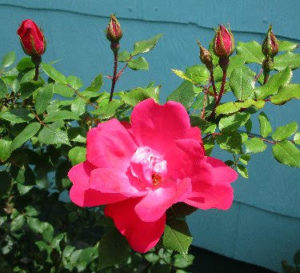
More knock-out roses
Joe Sapia, 59, is a vegetable gardener, who gardens the same backyard plot as did his Italian-American father, Joe Sr., and his Polish grandmother, Annie Poznanski Onda. Both are inspirations for his vegetable gardening. And he draws inspiration on the local Pine Barrens from his mother, Sophie Onda Sapia, who lived her whole life in the local Pines, and his grandmother.
Garden and Afield In Helmetta-Monroe-Jamesburg
2016, May 15, Sunday, to May 21, Saturday
by Joseph Sapia
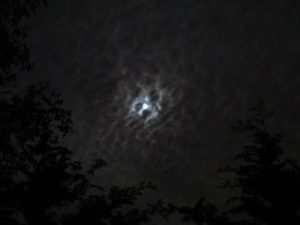
Nearly a Full Corn-Planting Moon during the week
— NIGHT SKY: On Saturday, the moon turned full, the Full Corn-Planting Moon. Look for a bright red Mars for weeks. (The photograph is of the almost-full moon over Monroe and Jamesburg.)
— VEGETABLE GARDENING: I got the vegetable garden in on Saturday, May 21, working in and out of rain. I am a bit concerned I went by the calendar, using May 20 as my guide to when the soil normally would be warm enough to plant, rather than by this year’s still-cool weather. That is, the soil may still be too cool for the warm-season vegetable plants. Perhaps I should have waited to June 1. No matter if I went with my heart over my head, the crop is in: Mammoth Gray-Stripe Sunflower, Cuppa Joe Sweet Corn, Rutgers Tomato, Hale’s Best Jumbo Cantaloupe, Born-to-be-Mild Hybrid Hot Pepper, Kaleidoscope Mix Carrot, Northern X-tra-Sweet Hybrid Sweet Corn, Igloo Lettuce, Carnival Mix Sweet Pepper, and Tasty Green Cucumber.
— OLD SEEDS: The Mammoth Gray-Stripe Sunflower, Cuppa Joe Sweet Corn, and Tasty Green Cucumber are 2015 seeds, which still should produce a crop.
— HOW I SEED: For what it is worth, I do not single-seed. Instead, I place a few to a bunch of seeds per hole.
— POLLINATION IN THE VEGETABLE GARDEN: I am trying something new in the garden, adding flowers to attract pollinators. So, I threw around seeds of Burpee’s Bee and Butterfly Garden and Monmouth Conservation Foundation’s Project Pollinator/Kids for Conservation.
— GARDENING ZONES: As the area transitions from the cooler Zone 6 to the warmer Zone 7, because of global warming, we will have a longer growing season. The gardening downside, more erratic weather. For example, many days of rain, followed by long periods of droughty weather. And, of course, the environmental downside is the global warming.
— RACCOONS AT THE BIRD-FEEDER: I enjoy watching the nightly visit of a raccoon or raccoons at the bird-feeder, sometime joined by a skunk below the feeder. I guess the raccoons and skunk like the sunflower hearts/kernels I use – and they have to eat, too, while entertaining me. But I got tired of the raccoon/s knocking down the feeder night after night. So, for now, I am bringing the feeder inside the garage at night and putting it back out in the morning.
— BIRDS: House finches were flying around the yard, fluttering to trees, bird-feeder, and clothesline, having trouble landing. They must have been fledglings, trying to figure it all out.
— WHIP-POOR-WILL CALLING: About 10:45 to 11 p.m. Wednesday night, May 18, a whip-poor-will called loudly, if only sporadically. This was once a common bird here in the local Pine Barrens – calling ad nauseam through the overnight. But this one was the first I have heard in an estimated 6 years. I got reports of whip-poor-will calls from around my Helmetta Road neighborhood, so I hoping for a return of the whip-poor-will.
— MOUNTAIN LAURELS AND SNAPPING TURTLES: Mountain laurel should begin blooming about now. So, remember this bit of Pine Barrens lore: “The snapping turtle lays its eggs, when the mountain laurel blooms.” Watch for snappers crossing roads – probably a female headed to high ground from a swamp to lay eggs or a female returning to a swamp after laying her eggs on high ground. If helping the turtle along, move it in the direction it is traveling. I MOVE A SNAPPER ONLY WITH A SHOVEL, because here is more Piney lore to think about, “Only the setting sun or lightning makes the snapping turtle let go.” If bitten, try running a wire down its nostril to make it let go. (Moving a snapper by lifting it by its tail could hurt it – and, also, it could bite the mover and not let go….)
(Garden observations are from my yard in the Helmetta Road area. Pine Barrens observations are from the Helmetta-Monroe area Pines.)
Joe Sapia, 59, is a vegetable gardener, who gardens the same backyard plot as did his Italian-American father, Joe Sr., and his Polish grandmother, Annie Poznanski Onda. Both are inspirations for his vegetable gardening. And he draws inspiration on the local Pine Barrens from his mother, Sophie Onda Sapia, who lived her whole life in the local Pines, and his grandmother.
Article and photos by Joe Mish
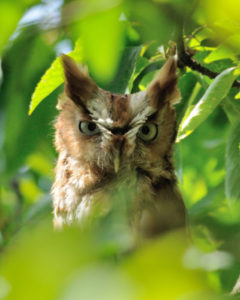
This female red phase screech owl with erect ear tufts and large eyes looks as ferocious as it sometimes sounds.
The calm starlit night, made blacker by the dark phase of the moon, was the perfect setting for a peaceful night’s sleep. The windows were wide open and the air scented with honeysuckle as the gentle sounds of the night played a sleepy time lullaby.
Deep sleep and dreams were well under way when a primal scream, just outside the window, vibrated the walls. Everyone sat up, hearts beating wildly, sleeping coonhounds unleashing unheard of sounds that must have been reserved in the event they ever treed the devil.
Before my heart beat slowed, I figured the sounds had to come from a screech owl perched on a tree limb six feet from the bedroom window. The unearthly screams were one selection of screech owl vocalizations that include rapid clicking of its beak and a gentle wavering call that, through association with spooky movies can easily raise the hairs on the back of your neck.
The volume of a screech owls’ motivated scream is inconsistent with its small size. The eastern screech owl is about 9 inches tall, weighs around 6 ounces with a 24 inch wingspan and easily fits through a three inch nest box hole.
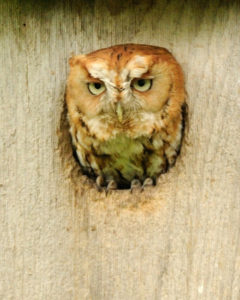
Adult red phase screech owl perches in 3″ hole of its nest box, note the feet gripping the edge of the opening.
Eastern screech owls come in two colors, a red phase and a gray phase. Its physical appearance, while perched, gives the impression it is missing the lower half of its body. During the day with its eyes shut it blends in so perfectly with its background it is difficult to tell what part is what. The owl seems to suddenly appear from the background when it opens its large yellow eyes.
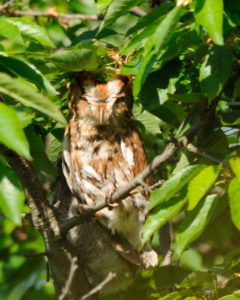
Eyes closed, these owls seems to disappear with no reference to top or bottom or recognizable form.
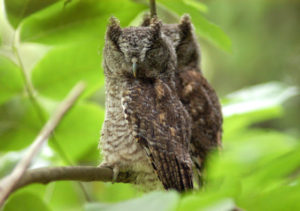
Screech owls seem to comfortably tolerate humans and can be seen, and will nest, in proximity to homes and buildings if a nest box is provided.
Late June early July, a screech owl would show up whenever I went into the backyard around dusk. It would follow me around and click its beak from a nearby branch. I have no idea what motivated that behavior but that owl provide plenty of photo opportunities.
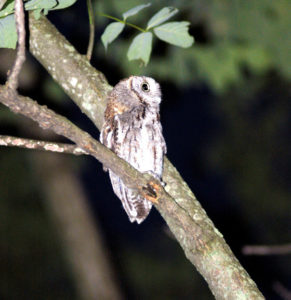
Then there were the memorable Christmas day visits. One Christmas morning I went to the open woodshed to replenish the woodstove with an armful of oak. There, staring me in the face from four feet away was a gray phase screech owl. It stayed put while I gathered the wood but was gone when I returned with my camera.
A few years later on Christmas night, a red phase screech owl perched a few feet off the ground in a weeping cherry tree. The little owl was spotted by the car’s headlights. It remained undisturbed while I did capture its image.
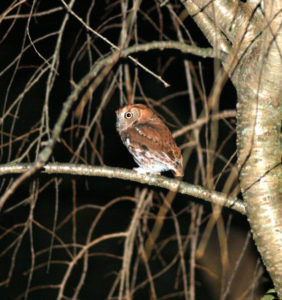
A late Christmas present in full feather, delivered at the front door.
Screech owls may just as well be found in deep woods. I have a great image of a red phase owl sitting in a healed hole in the side of a large tree trunk about eight feet off the ground. Other sightings have been in places where mature sycamore trees grow. Often, broken branches will leave a cavity that overtime becomes deeper, forming a perfect nest or day time resting place for this diminutive owl.
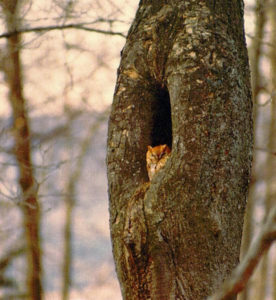
Though screech owls are quite common, you may never see one. Think of them as a night time radio host whose show you listen to all the time but never put a face to the voice. Hear a sampling of screech owl calls at: https://www.allaboutbirds.org/guide/Eastern_Screech-Owl/sounds
Author Joe Mish has been running wild in New Jersey since childhood when he found ways to escape his mother’s watchful eyes. He continues to trek the swamps, rivers and thickets seeking to share, with the residents and visitors, all of the state’s natural beauty hidden within full view. To read more of his writing and view more of his gorgeous photographs visit Winter Bear Rising, his wordpress blog. Joe’s series “Nature on the Raritan, Hidden in Plain View” runs monthly as part of the LRWP “Voices of the Watershed” series. Writing and photos used with permission from the author.
Our friend and “Voices of the Watershed: Pinelands of Helmetta” contributor Joe Sapia writes:
“Wow, I just heard a whip-poor-will calling at my house in the Helmetta Road area. That is the first time in about 6 years I have heard this bird, once a harbinger of spring in the local Pine Barrens, since about 2010.
Antrostomus vociferus is considered a jeopardized species in NJ. This one, I heard from about 10:45 p.m. to 11 p.m. Its call was powerful, meaning it was close, but it was sporadic, not the ad nauseam call.
Listen to an example and multiply that all night.
Around here, I would say this bird is a Pine Barrens bird, so it could be heard in parts of Monroe (north of Jamesburg and hugging the Old Bridge and Manalapan boundaries), anywhere in Helmetta and Spotswood, and other local Pine Barrens areas.
If you hear one locally, let me know when and the general location. Thanks.
A few weeks ago, I saw a brown thrasher, “Toxostoma rufum,” the first one I saw locally in years. What is going on?”
Article and photos by Joe Mish
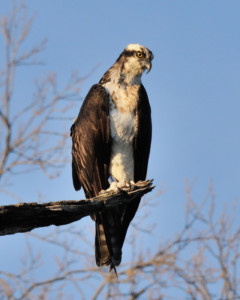
The osprey from Maine searches the clear water of the South Branch for a meal as she takes a break from her 2,500 mile journey north. The letters, DV, can be seen on the blue band attached to her right leg.
The warmth from the mid-morning sun felt good on my back as I paddled the low, clear water of the South Branch. The cloudless sky, directly above, was a darker shade of blue, its intensity pure and endless, and mesmerizing. It compelled me, as the devil’s advocate, to search for just a single speck to interrupt its perfection.
Suddenly a shadow sped across the water, momentarily stealing the sunlight. I instinctively looked up to catch a glimpse of an osprey circling above. The white head, streaked with a dark brown stripe, was instantly recognizable. The osprey proceeded downriver by making tight overlapping circles in its search for fish. It isn’t too hard to imagine some of these super intelligent predators realize a canoe is herding the fish ahead of it. When the osprey was about 150 yards downstream it tucked its wings and dove into foot deep water to come up with a large white sucker held fast in its black talons. The bird oriented the position of the fish to cut wind resistance as it flew out of sight.
Ospreys are ever present on the South Branch, typically from early spring to mid autumn. They feed primarily on live fish. I see them most often eating white suckers, a fish large enough to compensate for the energy spent to catch it.
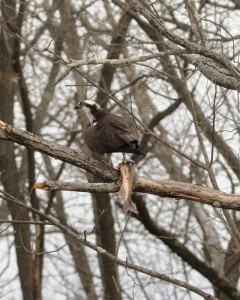
Osprey on a riverside perch, dining on fresh fish during the 2014 NJ opening day of trout season.
Earlier this April, I noticed an osprey perched in the same location day after day. This wasn’t typical of the local ospreys that ranged far and wide in their constant search for food. I was able to get a few photos and noticed a blue band on the right leg and a silver band on the left. I reported the band to the USGS website, BandReports@usgs.gov, to find this osprey was banded in Portland, Maine, July 27th, 2011 while it was still in the nest, too young to fly.
Osprey migrate from the northeast, where they breed, to central and South America each fall, a trip of more than 2,500 miles. This bird was apparently on its way back to Maine and stopped to rest. Osprey, like other migratory birds, are very loyal to nest sites and return to the same location with great predictability.
Consider our visiting osprey will be 5 years old this July, and has 25,000 plus, frequent flyer miles on its account, you have to recoil in amazement, wonder and respect for its strength and tenacity. As osprey can live 25 to 30 years or more, the mileage really adds up.
Our Maine visitor, a female, as evidenced by her speckled décolletage, has a bright and long future and hopefully will stop along the South Branch again on her journey to and from Central America. No doubt other osprey are flying to northern breeding grounds through NJ, so the opportunity to spot a banded bird along the North and South Branch are quite good.
The reporting of banded birds is critical to wildlife research as it helps to unravel the mystery of migration, the location of breeding grounds, longevity, and other variables that impact the health and status of local and overall wildlife populations.
New Jersey is now using red bands for osprey and from Ben Wurst at conservewildlifenj.org, as per USGS; “Green anodized bands are being used in NY. Purple anodized bands in MD and VA. Red anodized bands (like ours, but with alpha code A&B 00-99) in PA (permit is expired now). Blue anodized bands in MA, ME & Ontario.”
The preponderance of osprey nests in NJ are along the Delaware River and Atlantic shoreline, its estuaries, bays and rivers, so keep an eye out for banded birds and report them to BandReports@usgs.gov . The researchers are as excited about a band report as you and will send a certificate of appreciation with relevant data about your bird. Many species of birds are banded, so don’t forget our eagles, hawks and songbirds. Opportunities abound as NJ is on a major flyway, the rivers being main exit and entrance ramps to our backyard.
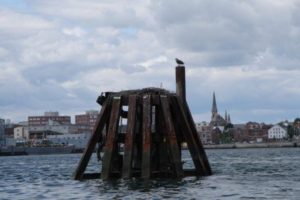
*Joe sent us an update to this post, a photo of the exact location in Maine where the osprey was born. Photo courtesy of Lauren Gilpatrick at the Biodiversity Research Institute, Portland Maine.
See, http://www.conservewildlifenj.org/education/ospreycam/ for more details about NJ osprey project and live osprey cam.
Special thanks to Robert Somes, Kathy Clark and Ben Wurst for their enthusiastic help and support.
Robert Somes, Senior Zoologist
NJ Division of Fish and Wildlife
Endangered and Nongame Species Program
Kathy Clark,CWB,
NJ Division of Fish and Wildlife
Endangered and Nongame Species Program,
Ben Wurst, Habitat Program Manager
New Jersey Osprey Project
Author Joe Mish has been running wild in New Jersey since childhood when he found ways to escape his mother’s watchful eyes. He continues to trek the swamps, rivers and thickets seeking to share, with the residents and visitors, all of the state’s natural beauty hidden within full view. To read more of his writing and view more of his gorgeous photographs visit Winter Bear Rising, his wordpress blog. Joe’s series “Nature on the Raritan, Hidden in Plain View” runs monthly as part of the LRWP “Voices of the Watershed” series. Writing and photos used with permission from the author.
Article and photos by Joe Mish
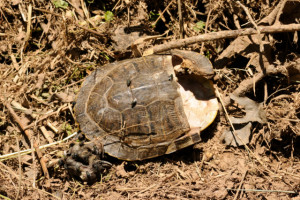
A slow journey that began more than a million years before, ended at the tip of a mower blade spinning at 3,200 rpm. This wood turtle, listed as ‘threatened’ in New Jersey, was killed in late May, while on its way to lay eggs.
May and June have been the peak of the great turtle migration where females, laden with eggs, leave the protection of quiet places to journey far and wide to dig holes and bury their eggs. Incubation takes about 70 days, more or less, and nests are left unattended.
All species, whether aquatic, terrestrial or both, like the wood turtle, seek dry land to lay eggs. Each has a preference for where and when they dig nests, though individual variation is the rule.
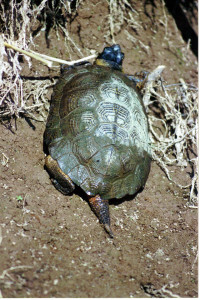
A wood turtle on its way out of the river where it hibernated to lay eggs in the gravel soil near railroad tracks.
Wood turtles prefer gravel laden soil on high ground, as found along railroad tracks, roadsides and driveways.
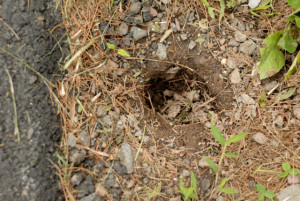
Roadways have become the killing fields for these slow moving reptiles where large blocks of undisturbed habitat are segmented by roads. A preserved island of land may be celebrated as a conservation success but the lack of linear greenways to bridge these islands is a death knell for many small creatures as it exposes them to predation and roadkill.
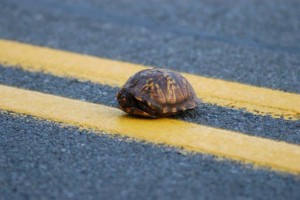
Eastern box turtle pauses mid journey across a New Jersey roadway, in a false retreat that offers no protection form speeding vehicles.
Turtles are creatures of habit and maintain consistent pathways from year to year. So that eastern box turtle you saw crossing over the double yellow line last year will be crossing the road in the same place this nesting season.
Mowing tall grass during nesting season is a more insidious cause of death for turtles and grassland nesting birds. Many farmers and landowners alter their mowing schedule to prevent killing fawns and game birds; turtles and grassland nesting birds are coincidental beneficiaries.
State conservation organizations advocate mowing early in the season and then not again until August, late July at the earliest.
A driver may possibly avoid killing a turtle on a paved road as it is somewhat visible, while a turtle in tall grass is a foregone conclusion when a mower runs through a field. The fractured shell of the wood turtle pictured, was found on a path mowed through an overgrown pasture near the South Branch.
Females may travel half a mile from wet areas to lay eggs, so please be careful. As the wood turtle is considered, “threatened “, and known to populate our area, special caution should be taken. May 29, 2015, a female wood turtle was observed digging a nest within inches of a long paved private drive, in hard packed gravel. This would be the last place you’d ever expect a turtle to dig, as you would be hard pressed with a pick and shovel to penetrate that ground. The hole was about 5 inches deep and 4 inches wide.
An awareness of turtles and their nest sites are a prerequisite to protecting them. As the eggs are laid in a small hole, covered and left unattended, you’d never know you were endangering a nest. Many eggs don’t hatch or are destroyed by predators. Then imagine an inch long hatchling trying to traverse a quarter mile through fields and open ground in an effort to reach water, bog or swamp. Survivors are few and far between.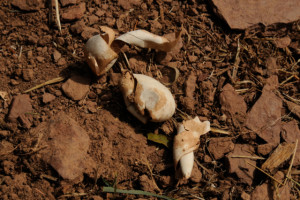
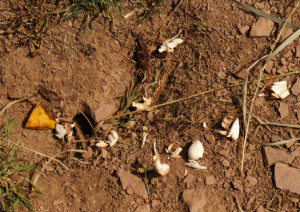
…you will find collapsed leathery egg shells scattered about; though they won’t look like egg shells. Imagine an egg shell make of cloth and inwardly collapsed to appear as a scrap of white material.
With poor odds for survival, it begs at least awareness on our part to, “first, do no harm”, and avoid destroying nests or mulching hatchlings and adults with a mower.
Turtles remain in their essential form that traces back to prehistoric times. Their evolution is an unrivaled success, even more astounding when their slow lumbering movements and low reproduction rate are considered.
Some interesting anatomical features reveal the secrets hidden behind the shell. See how the spinal cord is integral to the carapace or top shell in this painted turtle. The box turtle shell shows the spine as well as the clavicle. The thin plates that line the outer surface of the shell are attached much like a fingernail.
The easiest way to find a turtle nest is to look for the open holes in late summer and early fall. Either the nests were naturally opened by emerging turtlettes or dug out by raiding predators. In either case you will find collapsed leathery egg shells scattered about; though they won’t look like egg shells. Imagine an egg shell make of cloth and inwardly collapsed to appear as a scrap of white material. Last year I found 6 nests, one, just outside my back door. I had never seen a nest before but once I knew what to look for, they seemed to be everywhere.
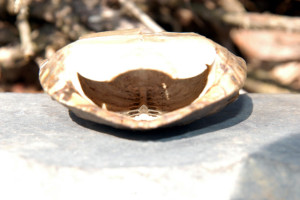
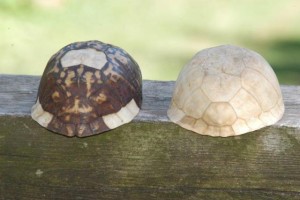
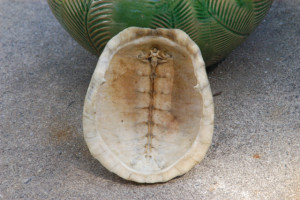
The Unami, one of the three matrilineal clans of the Lenape indians, who lived in central New Jersey, were known as the Turtle Clan. Treating the turtle with respect, keeps the clan of the turtle alive and well in the land it has known since the last glaciers receded and the land emerged from the sea. Consider, the turtle had arrived at it final evolutionary form long before humans. As new to the neighborhood, we might look to the turtle for guidance as we would a centenarian, to seek advice on how to live a long life in alignment and peace with our ever changing environment.
Author Joe Mish has been running wild in New Jersey since childhood when he found ways to escape his mother’s watchful eyes. He continues to trek the swamps, rivers and thickets seeking to share, with the residents and visitors, all of the state’s natural beauty hidden within full view. To read more of his writing and view more of his gorgeous photographs visit Winter Bear Rising, hiswordpress blog. Writing and photos used with permission from the author.
Articles and Photos by Joe Mish
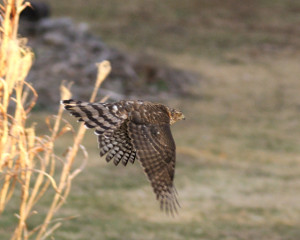
A cooper’s hawk flies off after landing in a holly tree where it jumped from branch to branch in an effort to flush a hiding songbird into the open.
Midwinter is a great time to catch a glimpse of local wildlife, especially hawks, as these large birds stand in dramatic contrast to the gray-brown leafless trees in which they perch.
The most common hawk in our region is the red-tailed hawk. Comparatively large, the adults are recognized by the bright russet colored tail. This is the only hawk whose tail is not banded or bordered by a contrasting color. The young birds have barred tail feathers, alternating russet and white, with no distinct borders.
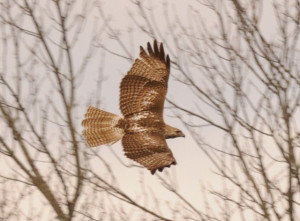
Easy to spot at highway speeds, the light breast and faded red tail stand out like a beacon when perched in trees along the roadway. Locally, I often see these hawks atop telephone poles near pastures and flood plains where they scan the open area for small mammals and ducks. Some red tails specialize in killing gray squirrels, a worthy meal for such a large bird whose energy expenditure in the winter would hardly be covered with mice or voles.
During a winter freeze when most of the river is solid ice, there are always open sections where ducks concentrate in the water and on the ice. A red tail will make an easy meal, especially of the smaller wood duck, flushing it into the air or catching it as it naps on the ice.
Last winter I watched an eagle feeding on a wood duck, speculation was the eagle took the duck from a red tail as eagles are notorious for stealing game from ospreys and hawks.
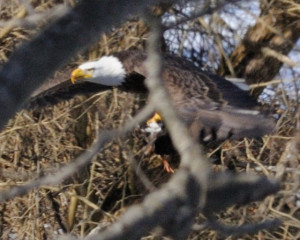
Muskrats are also high on the midwinter menu as the males often travel during the day over ice and snow as they seek food and females to breed.
A hawk requires a large nest and now is the time to scan the treetops and high tension towers for these stick built structures. One local hawk has adapted to a giant oak in someone’s backyard bordering a cluster of recently constructed homes. I have seen several local nests situated high in sycamore trees along the river. Hawk nests are relatively flat and large, not to be confused with squirrel nests which are numerous and quite round, generally built at a lower level, among thinner branches. Red tails will also use ledges as a base for their nests.
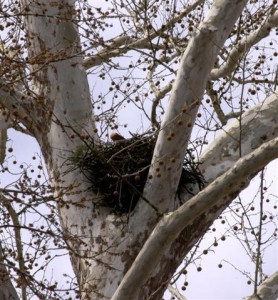
The ultimate adaptation belongs to the red tail known as, Pale Male, whose life is well documented in film, media and print as he has mated and bred several generations of hawks among the skyscrapers in mid Manhattan. His age is estimated at 24 years. Here is one site dedicated to Pale Male.
Marsh hawks share the sky with red tails and characteristically conduct ground hugging flights across overgrown fields, flood plains and grasslands and have an ability to hover in place. These hawks are slightly smaller than a red tail with dark brown coloration and a boldly banded tail. The key to identifying a marsh hawk is the bright white rump patch. These hawks are common, though not often seen and are known to migrate while red tails remain as full time residents.
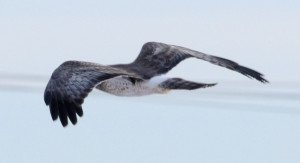
Aside from red tails, the most often seen hawks are the coopers and sharp-shinned hawks. The coopers being slightly larger than the sharp shinned. Both hawks feed on songbirds and small rodents. As each is similarly marked, identification is always controversial. More often than not, someone will submit a photo of a hawk to a website asking if it is a coopers or sharp-shinned and the replies are often split, each summarizing why they made their choice. I see the larger coopers preferring doves and rabbits while the sharp shinned has left piles of bluebird, indigo bunting and flicker feathers about the yard.
Lastly, look for the diminutive sparrow hawk, now known as the kestrel, typically perched on telephone poles and wires along open fields. This bird is about the size of a large dove, feeds on insects and small rodents. Kestrels are known for hovering before they dive on their prey and this stationary flight is a good identifying characteristic. The males are brilliantly marked with blue, shades of russet, black and white. At first glance a perched kestrel will appear as a songbird so be sure to give a second look. They are considered threatened in New Jersey and a nest box program and monitoring effort is having a positive effect on their recovery. The birds are easily baited and trapped for tagging and data collection.
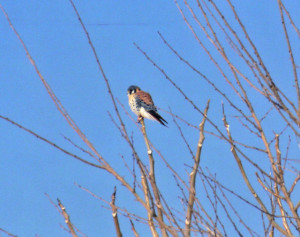
This is the winter of the hawk and hardly a commute is possible without being evaluated by a feathered predator. They can see you, can you see them?
Author Joe Mish has been running wild in New Jersey since childhood when he found ways to escape his mother’s watchful eyes. He continues to trek the swamps, rivers and thickets seeking to share, with the residents and visitors, all of the state’s natural beauty hidden within full view. To read more of his writing and view more of his gorgeous photographs visit Winter Bear Rising, his wordpress blog. Writing and photos used with permission from the author.























































